The motor should be good for ~1kW in this application if I can keep it cool. I hadn't planned on putting more than 500W into it though. I did a lot of homework on this project: bearings, grease, balancing, spindle design. I think I should have put more thought into the cooling and method to achieve balance. Balancing turned out OK, and I think the cooling will be OK as well.
You are using an out of date browser. It may not display this or other websites correctly.
You should upgrade or use an alternative browser.
You should upgrade or use an alternative browser.
High speed CNC spindle
- Thread starter mu38&Bg#
- Start date

Help Support Home Model Engine Machinist Forum:
This site may earn a commission from merchant affiliate
links, including eBay, Amazon, and others.
Hey Greg,
The motor will probably be the largest heat source on that spindle.
Having said that, I would make up a cooling jacket that fits over the OD of the motor.
You might have some luck with the liquid cooled micro processors chillers for workstations....
If you have some idea of the efficiency of the motor, you can estimate the heat dumped and size accordingly
I would need to know how your mounting the spindle to advise....
Dave
The motor will probably be the largest heat source on that spindle.
Having said that, I would make up a cooling jacket that fits over the OD of the motor.
You might have some luck with the liquid cooled micro processors chillers for workstations....
If you have some idea of the efficiency of the motor, you can estimate the heat dumped and size accordingly
I would need to know how your mounting the spindle to advise....
Dave
A very non exhaustive search turned up this.....CHEAP hardware
http://www.koolance.com/water-cooling/new_products.php
Dave
http://www.koolance.com/water-cooling/new_products.php
Dave
Dave, I haven't checked the idle current draw of the spindle yet. I've looked at PC cooling hardware for something else, but it didn't come to mind for the spindle. I have a chiller unit that I think is rated at 500W maximum. The motor heat loss is easy and I can find the bearing heat load. I'll definitely consider the radiator though. I doubt I'll need active cooling.
If you've ever seen a Precise spindle mount that's the plan. I think I'll have to order a block of material. I
Another note, I picked up a balanced Rego Fix ER16 collet nut and wrench locally. The same guy has some connections and might be able to get me the TOS chuck I want for the Emco lathe.
If you've ever seen a Precise spindle mount that's the plan. I think I'll have to order a block of material. I
Another note, I picked up a balanced Rego Fix ER16 collet nut and wrench locally. The same guy has some connections and might be able to get me the TOS chuck I want for the Emco lathe.
Lot's depends on what the numbers are. The mount is as I imangined it would be. Should be plenty ridgid enough.
A simple expedient of a large heat sink and a fan might do it.
The key to keeping the change in temperature down to a minimum, is to keep the flow rate of the heat transfer fluid high.
Whether it's water, glycol, or air. Water and Glycol have very large heat capacity, so they can do this more effectively for a given heat transfer coefficient and heat transfer area....but it's not the only way, and an air cooled system sure is simple.
Keep us informed.
Dave
A simple expedient of a large heat sink and a fan might do it.
The key to keeping the change in temperature down to a minimum, is to keep the flow rate of the heat transfer fluid high.
Whether it's water, glycol, or air. Water and Glycol have very large heat capacity, so they can do this more effectively for a given heat transfer coefficient and heat transfer area....but it's not the only way, and an air cooled system sure is simple.
Keep us informed.
Dave
Greg,
I have built a similar spindle (doesn't look so nice though!) with a totally enclosed motor to which I have added a copper water jacket, a small pump (ex windscreen washer) and I circulate my water based cutting fluid through it. Advantage is that there is a large reservoir which substitutes for any radiators and that the fluid 'wets' onto the outside of the motor body.
During my setup tests, I was unsure whether the cooling was going to be necessary so I had a digital thermometer probe attached to the body with a blob of heat transfer paste to ensure the reading was reasonably accurate. My 500W motor rose from 18°C (65°F) to 45°C (113°F) in the space of around 8 minutes.
The documentation that came with my motor and casual searching on the web suggests that the rare earth magnets that these motors use should not be allowed to exceed 100°C (212°F) hence the swift construction of the water jacket. I have run it for about 30 minutes non stop and the temperature now rises by no more than 2-3°C, so a worthwhile exercise.
Simon
I have built a similar spindle (doesn't look so nice though!) with a totally enclosed motor to which I have added a copper water jacket, a small pump (ex windscreen washer) and I circulate my water based cutting fluid through it. Advantage is that there is a large reservoir which substitutes for any radiators and that the fluid 'wets' onto the outside of the motor body.
During my setup tests, I was unsure whether the cooling was going to be necessary so I had a digital thermometer probe attached to the body with a blob of heat transfer paste to ensure the reading was reasonably accurate. My 500W motor rose from 18°C (65°F) to 45°C (113°F) in the space of around 8 minutes.
The documentation that came with my motor and casual searching on the web suggests that the rare earth magnets that these motors use should not be allowed to exceed 100°C (212°F) hence the swift construction of the water jacket. I have run it for about 30 minutes non stop and the temperature now rises by no more than 2-3°C, so a worthwhile exercise.
Simon
Thank you, Simon, for the information. This motor has high temperature magnets, probably 150°C. I know one guy that builds spindles like this ran his coolant through the spindle motor and then on the parts, and then back to the tank. I don't remember exactly how he was filtering it, but he was happy. A large reservoir is simpler and more reliable than a radiator and fan.
The reason I considered using compressed air through the motor was because of an experience I had with a brushed motor in an RC model years ago. I set it up such the the cooling air flowed through, not around the motor like most designs. The result was very obvious in reduced heating and consistent power through the flight. It doesn't take much air when you can get directly to the parts that need it. Of course in this case I'll probably do the math before trying it.
Greg
The reason I considered using compressed air through the motor was because of an experience I had with a brushed motor in an RC model years ago. I set it up such the the cooling air flowed through, not around the motor like most designs. The result was very obvious in reduced heating and consistent power through the flight. It doesn't take much air when you can get directly to the parts that need it. Of course in this case I'll probably do the math before trying it.
Greg
Greg, I think the simple act of mounting that beauty in a nice fitting block of decent mass will take care of 90% of any heat issues. I have a KaVo spindle of very similar profile that I mounted in a big aluminum block mount that was precision-bored to take the OD of the spindle. The block in turn dumps any heat into its own mount.
Even at high/long sustained effort, the setup barely feels warm. I'd try it first without anything exotic. Plain old heat transmission through metal will hopefully do the trick.
My system does take filtered, compresses air internally which certainly helps cool, and also creates positive pressure internally to protect the bearings.
The commercial variants of this spindle type are unbelievably smooth running. Again with my KaVo at 50K RPM, there is barely any noticeable vibration. It looks like you have replicated a complex and expensive spindle at home. A superior job and beautiful results.
Even at high/long sustained effort, the setup barely feels warm. I'd try it first without anything exotic. Plain old heat transmission through metal will hopefully do the trick.
My system does take filtered, compresses air internally which certainly helps cool, and also creates positive pressure internally to protect the bearings.
The commercial variants of this spindle type are unbelievably smooth running. Again with my KaVo at 50K RPM, there is barely any noticeable vibration. It looks like you have replicated a complex and expensive spindle at home. A superior job and beautiful results.
The mount is turning out to be a lot of work, which I somewhat expected.
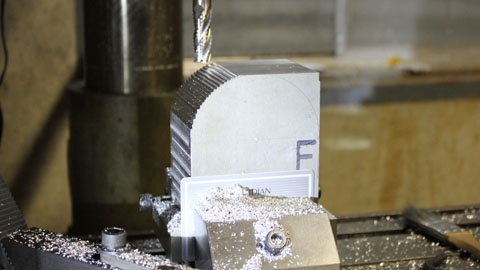
I started with a block of 7075-T6 about 4.25"x5.5"x2.6" and hogged most of it in the Arboga.
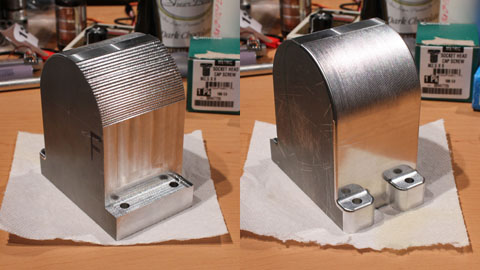
On the left, before CNC, on the right after. The second side is still running in the mill. It's a 2 1/2 hour program mostly due to the feed limitations I have right now. After that will come cutting the hole for the clamp screws, boring the hole for the spindle, and finally splitting it with a saw in the mill. I never paint my tools, but this might get a coat of something. I'd anodize it if I was set up for it. There is one booboo from thinking about Paczki on Fat Tuesday when I should have been thinking about which way to crank the mill handles.
Greg

I started with a block of 7075-T6 about 4.25"x5.5"x2.6" and hogged most of it in the Arboga.

On the left, before CNC, on the right after. The second side is still running in the mill. It's a 2 1/2 hour program mostly due to the feed limitations I have right now. After that will come cutting the hole for the clamp screws, boring the hole for the spindle, and finally splitting it with a saw in the mill. I never paint my tools, but this might get a coat of something. I'd anodize it if I was set up for it. There is one booboo from thinking about Paczki on Fat Tuesday when I should have been thinking about which way to crank the mill handles.
Greg
Yes, it will be split. Right now, I a little stuck. I have a faceplate for the lathe that feels a little too small for this. I think I can do it safely if I make a plate to clamp the mount to it, but I'm only going to be able to use three bolts. Then machine right through that plate. The four jaw chuck I have would hold it but I don't feel comfortable using it. I suppose if I kept the cuts light it would be safe. I do have a large four jaw that's been waiting for a new backplate to fit the Clausing, but I don't have a spare backplate to machine. Because I don't do any coarse internal threading, I don't have an internal threading tool even though I do have a chunk of suitable cast iron allotted to another project.
Ooops, I typed that yesterday and it's still here on my screen.
Anyhow here are a few more pictures. The chunk of cast iron was spotted elsewhere in the shop after I started cutting the backplate. It must be a piece I got in a toolbox I bought. Steel of some sort, actually pretty tough stuff to drill and tap, but turning was awesome. The backplate turned out fine and I mounted the large four jaw I had. Boring is not done yet. Slow going due to low speed, unbalance, and somewhat scary setup.
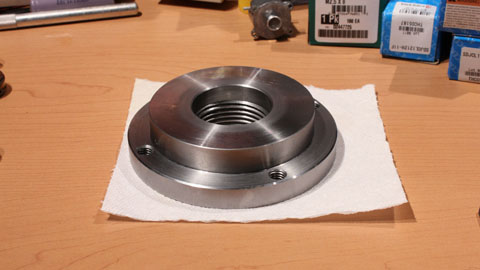
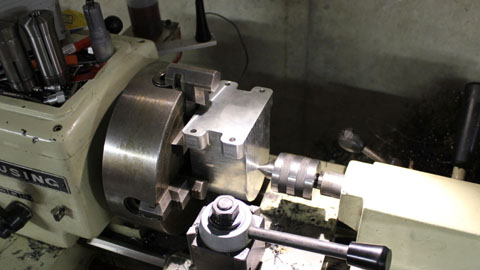
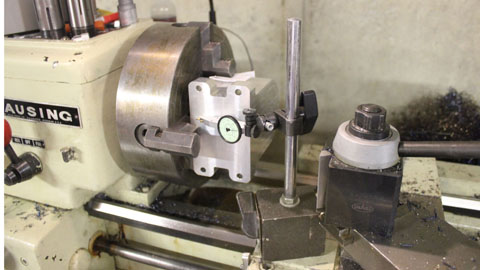
Ooops, I typed that yesterday and it's still here on my screen.
Anyhow here are a few more pictures. The chunk of cast iron was spotted elsewhere in the shop after I started cutting the backplate. It must be a piece I got in a toolbox I bought. Steel of some sort, actually pretty tough stuff to drill and tap, but turning was awesome. The backplate turned out fine and I mounted the large four jaw I had. Boring is not done yet. Slow going due to low speed, unbalance, and somewhat scary setup.



Well, the setup I have now doesn't use anything to align it. Once installed/trammed it doesn't get moved so I don't use any pins or adjuster screws, etc. My mill is probably not what you think.....
Brass_Machine
Well-Known Member
- Joined
- Aug 28, 2007
- Messages
- 1,314
- Reaction score
- 7
dieselpilot said:Well, the setup I have now doesn't use anything to align it. Once installed/trammed it doesn't get moved so I don't use any pins or adjuster screws, etc. My mill is probably not what you think.....
I hadn't seen your mill before... I knew it was DIY, but I didn't know it had a concrete column. How does it perform?
Eric



